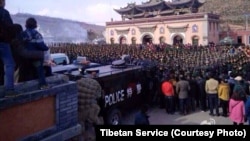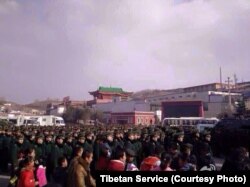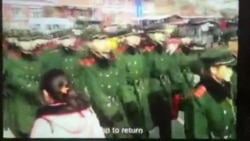Photos and videos surfacing on Chinese social media show a heavy security presence at the annual Monlam Prayer Festival at Kumbum monastery, in a region with a large Tibetan population in China's Qinghai province.
VOA's Tibet Service obtained several photos from China's Weibo social media service and other sources that show hundreds of heavily-armed police officers surrounding worshippers gathered at the Kumbum monastery in Xining, the capital of Qinghai province. China's censors usually scrub such photos from social media, but they often get forwarded to media outlets before that can be done.
The Monlam festival, which dates back to 1409, begins on the third day of the Tibetan new year. The event is dedicated to teachers of all religious traditions, social harmony and world peace, and it takes place all across Tibet. Kumbum monastery’s Monlam festival is famous for its highly spectacular and intricate displays of colored butter sculptures, which address religious and historical subjects.
The festival was banned during the early years of China’s rule of Tibet in the 1960s and 1970s, when thousands of monasteries were destroyed and monks were either killed or forcibly disrobed.
The heavy security presence, with armored vehicles and troops armed with automatic weapons conducting drills and marching through one of the major Tibetan monasteries, appears to have upset many the Tibetans in the area. In rare acts of expression on the heavily policed social media sites, one person asked, "Are we supposed to watch the army or watch the prayer festival?" Another said "I was so afraid that I forgot to pray."
One person contrasts the armed force with China’s repeated calls for social stability, writing: "With this many soldiers at a prayer festival, are you working for harmony or war?"
Since 2008, hundreds of Tibetan monasteries have experienced sustained crackdowns and restrictions from Chinese security and propaganda agencies, with thousands of monks and nuns being put through re-education programs where they are made to renounce the Tibetan spiritual leader, the Dalai Lama.
In the past, refusing to comply has resulted in monks and nuns being expelled from their monasteries, and even detained and tortured.
China took control of Tibet, which it had long claimed, in 1950. In 1959, the Dalai Lama fled to India, where he leads an exile community. Tibetan exiles have long warned that their cultural and religious traditions are being suppressed as ethnic Han Chinese, who make up the majority of the Chinese population, have moved into the region and now dominate its local economy.
Beijing rejects those complaints and says it has taken steps to protect minority rights and provide economic growth. China's government considers the Dalai Lama a separatist bent on breaking up the nation. The Dalai Lama has said repeatedly he wants only for more autonomy for the Tibet and protection for the Tibetan culture.
WATCH: Mobile video posted on Weibo











